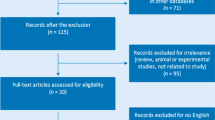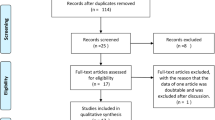Abstract
Previous surveys had evaluated the effects of the PD-1, CTLA-4 gene polymorphisms on susceptibility to ankylosing spondylitis (AS), but the results remained controversial. To briefly examine these consequences, a comprehensive meta-analysis was conducted to estimate the relationships between PD-1 rs11568821, rs2227982, rs2227981, CTLA-4 +49 A/G and −318 C/T polymorphisms and AS risk. The available articles dated to December 2014 were searched in the PUBMED, MEDLINE and EMBASE databases. The data of the genotypes and/or alleles for the PD-1 rs11568821, rs2227982, rs2227981, CTLA-4 +49 A/G and −318 C/T polymorphisms in the AS and control subjects were extracted, and statistical analysis was conducted by STATA 11.2 software. Summary odds ratios (ORs) with their 95 % confidence intervals (95 % CIs) were calculated to determine the strength of associations with fixed-effects or random-effects models. A total of eight published studies were finally involved in this meta-analysis. Meta-analysis of PD-1 rs2227982 polymorphism under the T allele versus C allele (OR 1.744, 95 % CI 1.477–2.059, P < 0.0001), TT+TC versus CC (OR 2.292, 95 % CI 1.654–3.175, P < 0.0001), TT versus CC (OR 1.883, 95 % CI 1.299–2.729, P = 0.001) revealed a significant association with AS. Our meta-analysis demonstrated that the rs2227982 polymorphism in the PD-1 gene might contribute to AS susceptibility. However, further studies with large sample sizes and among different ethnicity populations should be required to confirm this association.







Similar content being viewed by others
References
Brown MA, Wordsworth BP, Reveille JD (2002) Genetics of ankylosing spondylitis. Clin Exp Rheumatol 20:S43–S49
Ng SC, Liao Z, Yu DT et al (2007) Epidemiology of spondyloarthritis in the People’s Republic of China: review of the literature and commentary. Semin Arthritis Rheum 37:39–47
Dean LE, Jones GT, MacDonald AG et al (2014) Global prevalence of ankylosing spondylitis. Rheumatology 53:650–657 (Oxford)
Brown MA, Laval SH, Brophy S et al (2000) Recurrence risk modelling of the genetic susceptibility to ankylosing spondylitis. Ann Rheum Dis 59:883–886
Brewerton DA, Hart FD, Nicholls A et al (1973) Ankylosing spondylitis and HL-A 27. Lancet 1:904–907
Brown MA, Kennedy LG, Darke C et al (1998) The effect of HLA-DR genes on susceptibility to and severity of ankylosing spondylitis. Arthritis Rheum 41:460–465
Duan Z, Pan F, Zeng Z et al (2012) Interleukin-23 receptor genetic polymorphisms and ankylosing spondylitis susceptibility: a meta-analysis. Rheumatol Int 32:1209–1214
Prokunina L, Castillejo-Lopez C, Oberg F et al (2002) A regulatory polymorphism in PDCD1 is associated with susceptibility to systemic lupus erythematosus in humans. Nat Genet 32:666–669
Nishimura H, Okazaki T, Tanaka Y et al (2001) Autoimmune dilated cardiomyopathy in PD-1 receptor-deficient mice. Science 291:319–322
Nishimura H, Honjo T (2001) PD-1: an inhibitory immunoreceptor involved in peripheral tolerance. Trends Immunol 22:265–268
Latchman Y, Wood CR, Chernova T et al (2001) PD-L2 is a second ligand for PD-1 and inhibits T cell activation. Nat Immunol 2:261–268
Freeman GJ, Long AJ, Iwai Y et al (2000) Engagement of the PD-1 immunoinhibitory receptor by a novel B7 family member leads to negative regulation of lymphocyte activation. J Exp Med 192:1027–1034
Ansari MJ, Salama AD, Chitnis T et al (2003) The programmed death-1 (PD-1) pathway regulates autoimmune diabetes in nonobese diabetic (NOD) mice. J Exp Med 198:63–69
Salama AD, Chitnis T, Imitola J et al (2003) Critical role of the programmed death-1 (PD-1) pathway in regulation of experimental autoimmune encephalomyelitis. J Exp Med 198:71–78
Greenwald RJ, Oosterwegel MA, van der Woude D et al (2002) CTLA-4 regulates cell cycle progression during a primary immune response. Eur J Immunol 32:366–373
Lee YH, Harley JB, Nath SK (2005) CTLA-4 polymorphisms and systemic lupus erythematosus (SLE): a meta-analysis. Hum Genet 116:361–367
Liu X, Hu LH, Li YR et al (2011) Programmed cell death 1 gene polymorphisms is associated with ankylosing spondylitis in Chinese Han population. Rheumatol Int 31:209–213
Qian BP, Wang XQ, Qiu Y et al (2013) An exon polymorphism of programmed cell death 1 gene is associated with both the susceptibility and thoracolumbar kyphosis severity of ankylosing spondylitis in a Chinese Han population. J Orthop Sci 18:514–518
Soleimanifar N, Amirzargar AA, Mahmoudi M et al (2011) Study of programmed cell death 1 (PDCD1) gene polymorphims in Iranian patients with ankylosing spondylitis. Inflammation 34:707–712
Lee SH, Lee YA, Woo DH et al (2006) Association of the programmed cell death 1 (PDCD1) gene polymorphism with ankylosing spondylitis in the Korean population. Arthritis Res Ther 8:R163
Yang Q, Liu Y, Liu D et al (2011) Association of polymorphisms in the programmed cell death 1 (PD-1) and PD-1 ligand genes with ankylosing spondylitis in a Chinese population. Clin Exp Rheumatol 29:13–18
Huang CH, Wei JC, Chen CC et al (2014) Associations of the PTPN22 and CTLA-4 genetic polymorphisms with Taiwanese ankylosing spondylitis. Rheumatol Int 34:683–691
Azizi E, Massoud A, Amirzargar AA et al (2010) Association of CTLA4 gene polymorphism in Iranian patients with ankylosing spondylitis. J Clin Immunol 30:268–271
Lee WY, Chang YH, Lo MK et al (2010) Polymorphisms of cytotoxic T lymphocyte-associated antigen-4 and cytokine genes in Taiwanese patients with ankylosing spondylitis. Tissue Antigens 75:119–126
Higgins JP, Thompson SG, Deeks JJ et al (2003) Measuring inconsistency in meta-analyses. BMJ 327:557–560
Brittain EH, Fay MP, Follmann DA (2012) A valid formulation of the analysis of noninferiority trials under random effects meta-analysis. Biostatistics 13:637–649
Chootrakool H, Shi JQ, Yue R (2011) Meta-analysis and sensitivity analysis for multi-arm trials with selection bias. Stat Med 30:1183–1198
Sterne JA, Egger M, Smith GD (2001) Systematic reviews in health care: investigating and dealing with publication and other biases in meta-analysis. BMJ 323:101–105
Munafo MR, Clark TG, Flint J (2004) Assessing publication bias in genetic association studies: evidence from a recent meta-analysis. Psychiatry Res 129:39–44
Chen X, Zhou X, Li X et al (2014) Effects of Tumor Necrosis Factor Inhibitor on Serum Level of HLA-B27 and PDCD-1 in Patients with Ankylosing Spondylitis. Cell Biochem Biophys 70:1453–1457
Bautista-Caro MB, Arroyo-Villa I, Castillo-Gallego C et al (2014) Decreased frequencies of circulating Follicular Helper T Cell counterparts and plasmablasts in Ankylosing Spondylitis patients naive for TNF blockers. PLoS One 9:e107086
Xiao F, Zhang HY, Liu YJ et al (2013) Higher frequency of peripheral blood interleukin 21 positive follicular helper T cells in patients with ankylosing spondylitis. J Rheumatol 40:2029–2037
Chen MH, Chen WS, Lee HT et al (2011) Inverse correlation of programmed death 1 (PD-1) expression in T cells to the spinal radiologic changes in Taiwanese patients with ankylosing spondylitis. Clin Rheumatol 30:1181–1187
Bleil J, Maier R, Hempfing A et al (2014) Histomorphologic and histomorphometric characteristics of zygapophyseal joint remodeling in ankylosing spondylitis. Arthritis Rheumatol 66:1745–1754
Huang ZX, Tan JH, Li TW et al (2013) Influence of sinomenine on protein profiles of peripheral blood mononuclear cells from ankylosing spondylitis patients: a pharmacoproteomics study. Chin Med J 126:3645–3650 (Engl)
Britanova OV, Staroverov DB, Chkalina AV et al (2011) Single high-dose treatment with glucosaminyl-muramyl dipeptide is ineffective in treating ankylosing spondylitis. Rheumatol Int 31:1101–1103
Yang ZX, Liang Y, Zhu Y et al (2007) Increased expression of Toll-like receptor 4 in peripheral blood leucocytes and serum levels of some cytokines in patients with ankylosing spondylitis. Clin Exp Immunol 149:48–55
Duftner C, Goldberger C, Falkenbach A et al (2003) Prevalence, clinical relevance and characterization of circulating cytotoxic CD4+ CD28-T cells in ankylosing spondylitis. Arthritis Res Ther 5:R292–R300
van der Paardt M, Crusius JB, de Koning MH et al (2003) CARD15 gene mutations are not associated with ankylosing spondylitis. Genes Immun 4:77–78
Hickey EJ, Raje RR, Reid VE et al (2001) Diclofenac induced in vivo nephrotoxicity may involve oxidative stress-mediated massive genomic DNA fragmentation and apoptotic cell death. Free Radic Biol Med 31:139–152
Huang CH, Wong RH, Wei JC et al (2011) Effects of genetic polymorphisms of programmed cell death 1 and its ligands on the development of ankylosing spondylitis. Rheumatology 50:1809–1813 (Oxford)
Lee YH, Bae SC, Kim JH et al (2014) Meta-analysis of genetic polymorphisms in programmed cell death 1: Associations with rheumatoid arthritis, ankylosing spondylitis, and type 1 diabetes susceptibility. Z Rheumatol 74(3):230–239
Yang M, Zou Y, Bai Y et al (2014) The programmed cell death 1 gene polymorphisms (PD 1.3 G/A, PD 1.5 C/T and PD 1.9 C/T) and susceptibility to ankylosing spondylitis: a meta-analysis. J Orthop Sci 20(1):55–63
Reveille JD, Sims AM, Danoy P et al (2010) Genome-wide association study of ankylosing spondylitis identifies non-MHC susceptibility loci. Nat Genet 42:123–127
Acknowledgments
We thank all our colleagues working in the Department of Rheumatology and Clinical Immunology, Peking Union Medical College Hospital, Chinese Academy of Medical Sciences and Peking Union Medical College, Key Laboratory of Rheumatology and Clinical Immunology.
Funding
This work was supported by funding from the Research Special Fund for Public Welfare Industry of Health (201202004), and the National Natural Science Foundation of China Grants (81172857, 81373188), the Chinese National High Technology Research and Development Program, Ministry of Science and Technology Grants (2011AA02A113), and the National Science Technology Pillar Program in the 12th 5-year Plan (2014BAI07B00).
Author information
Authors and Affiliations
Corresponding author
Ethics declarations
Conflict of interest
The authors declare that they have no conflict of interest.
Ethical standard
The study was approved by the Ethics Committee of the Peking Union Medical College Hospital.
Additional information
Si Chen, Yuan Li and Chuiwen Deng have contributed equally to this manuscript.
Rights and permissions
About this article
Cite this article
Chen, S., Li, Y., Deng, C. et al. The associations between PD-1, CTLA-4 gene polymorphisms and susceptibility to ankylosing spondylitis: a meta-analysis and systemic review. Rheumatol Int 36, 33–44 (2016). https://doi.org/10.1007/s00296-015-3327-9
Received:
Accepted:
Published:
Issue Date:
DOI: https://doi.org/10.1007/s00296-015-3327-9




